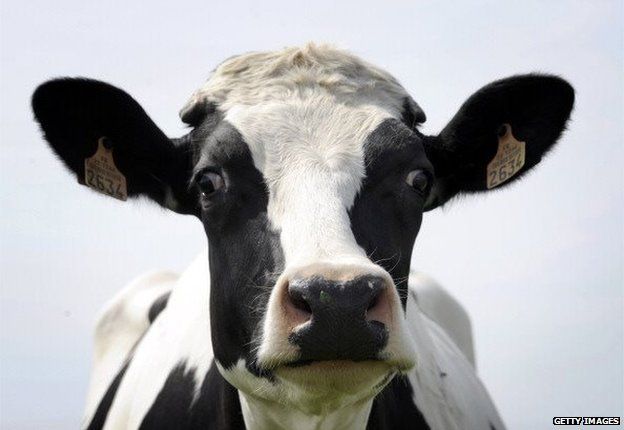Cow researchers find meanings behind moos
- Published

Researchers have recorded and analysed the ways cows communicate with their young, to translate the meanings behind the "moos".
They identified two distinctly different call sounds that cows make to their calves, depending on whether they are nearby or separated.
They also identified a call calves make to their mothers when they want to start suckling milk.
The cows were studied at a farm in Radcliffe-on-Trent, Nottinghamshire.
The team from the University of Nottingham and Queen Mary University of London spent ten months digitally recording the cow sounds, then a year analysing them using computers.
Just as human voices differ from each other, the researchers confirmed that cows make their own unique sounds.
Three moo calls identified
Listen to a low frequency call, high frequency call and a calf call
Low frequency calls (LFCs) were produced by cows when they were in close proximity to their calves, in the three or four weeks after birth. These were quiet and were made with the mouth closed or only partially open.
Louder high frequency calls (HFCs) were produced by cows when they were separated from their calves (not in visual contact) and preceded nursing.
Calf calls were produced when they were separated from their mothers and wanted to suckle milk
Dr Mónica Padilla de la Torre, who led the project, said: "The research shows for the first time that mother-offspring cattle calls are individualised - each calf and cow have a characteristic and exclusive call of their own.
"Acoustic analysis also reveals that certain information is conveyed within the calf calls - age, but not gender."
The cows made low frequency calls when close to their calves
Two crossbred beef cattle herds were studied at a farm in Radcliffe-on-Trent, Nottinghamshire
Fellow researcher Dr Alan McElligott said it was the "first time that complex cattle calls have been analysed using the latest and best techniques".
The researchers say their methods of recording and analysing cow sounds could be used to identify indicators of animal welfare, for example, the sounds cows make when they are distressed.
The researchers said it had long been thought that cows use individualised calls to communicate with each other, but this study confirms the theory.
'Almost talking to calf'
Farmer James Bourne, who has been around cows since the 1950s, said the research supports what he has always noticed himself.
"A calf certainly knows its mother from other cows, and when a calf blarts the mother knows it's her calf," said Mr Bourne, who is a farmer in Lincolnshire.
"If they are not distressed and they are calm they will moo fairly low to the calf, almost talking to their calf.
"If they are distressed, in other words they have lost their calf or are separated from their calf, it's a much higher pitched moo.
"She starts bleating louder and louder because she's distressed because he's away from her."
The researchers recorded the cows sounds using highly sensitive digital recorders
- Published8 May 2013
- Published1 November 2013